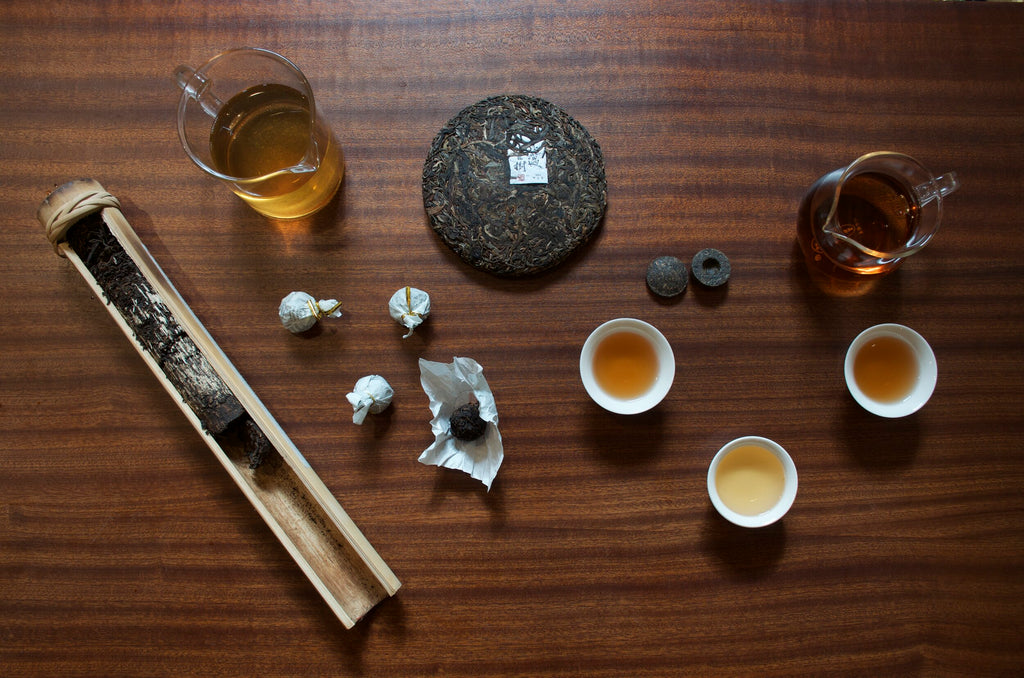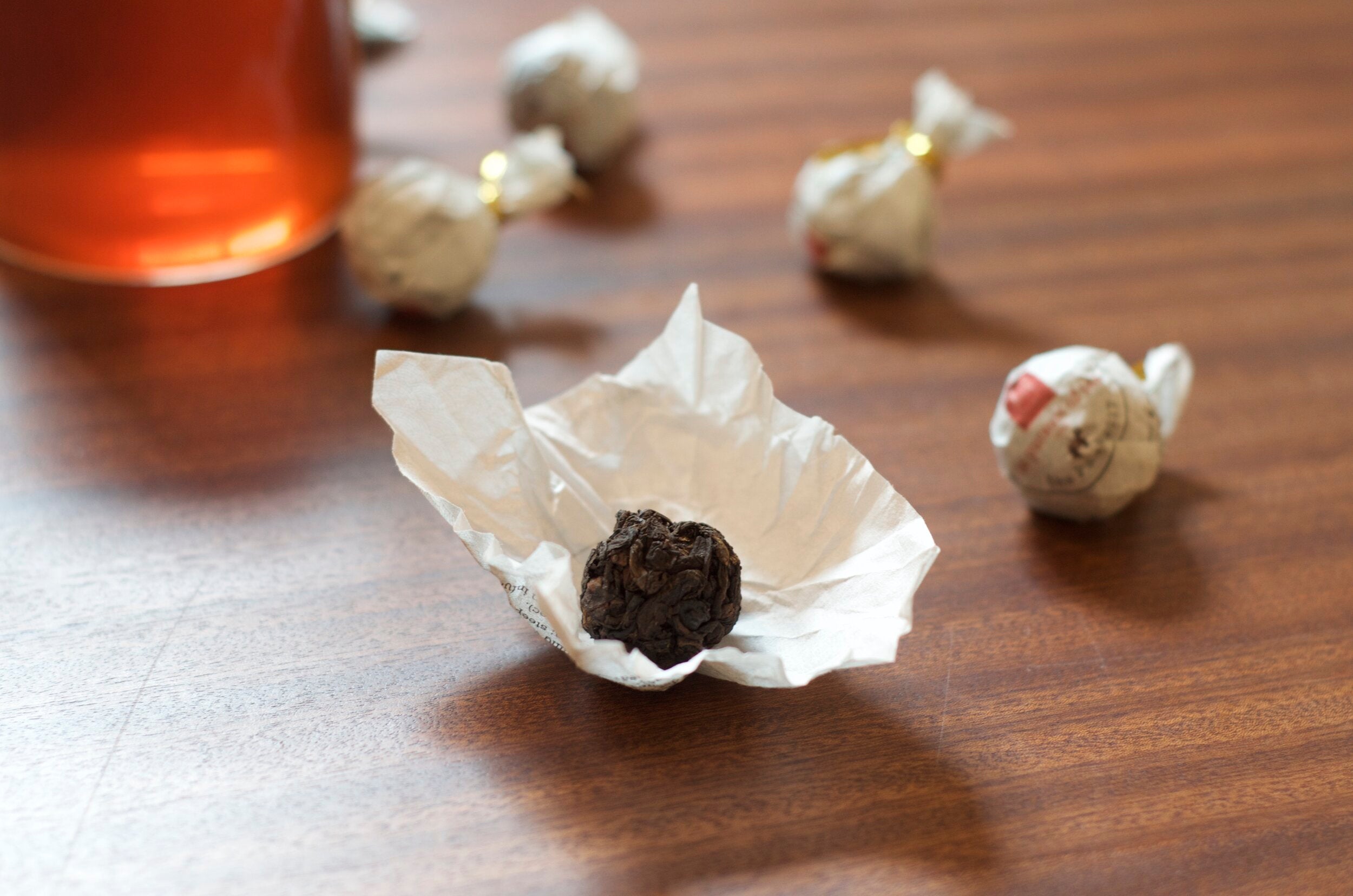New Pu-erh Tea to Drink Right Now—and Later

Pu-erh is the only type of tea that comes in a toy box’s worth of shapes. There are discus-like bingchas, bird’s nest tuochas, compressed bricks and squares—and those are just the most popular forms. Tea shops throughout Yunnan Province, where pu-erh originated, are wise to this; if you’d like a commemorative hunk of tea pressed into a relief of an elephant, you have several options to choose from.
On recent trips to Yunnan, we’ve been impressed with the range and quality of new designs from processing facilities. While the technique of compressing pu-erh leaves into dense blocks was most likely developed hundreds of years ago out of convenience—to more efficiently transport large amounts of tea safely on the back of a man or mule, without the need for extra packaging—some more modern shapes offer newly approachable ways to help drinkers explore the vast and often intimidating world of pu-erh tea.

Some of these designs focus on small, single-serving formats that allow drinkers to sample a pu-erh without committing to the traditional full-size ¾ lb bingcha. “Chocolate bars,” for instance, are scored with lines that allow a serving of tea to be easily broken off with one’s hands. Spherical “dragon balls,” as they’re sometimes called, can be individually dropped directly in a pot or cup, no other measurements required.
In past decades, the low-quality leaf pressed into these non-standard shapes rendered them a novelty rather than something for serious drinkers; the best leaf material was usually saved for bingchas. Today, however, high-quality pu-erh can be found in a wide range of forms, and we’re excited to share some of our new collection.
Shu Truffle Pu-erh
 Others may call them dragon balls, but to us, these 6-gram spheres of shu-style pu-erh are truffles—just as dark, sweet, and delectable. They’re made from tea that was harvested and processed in 2017. After three years of resting, they’re ready for their first dance, with a rich, loamy fragrance that develops into a balanced brew full of mushroom and orange peel aromas.
Others may call them dragon balls, but to us, these 6-gram spheres of shu-style pu-erh are truffles—just as dark, sweet, and delectable. They’re made from tea that was harvested and processed in 2017. After three years of resting, they’re ready for their first dance, with a rich, loamy fragrance that develops into a balanced brew full of mushroom and orange peel aromas.
Infuse for several steepings in a gaiwan, or simply toss one in a mug and top it off with more hot water throughout the day. It’s also a good idea to keep a few in your pocket if you’re headed to a Chinese restaurant for dim sum—or into the car for a road trip.
Sheng Cupcake Pu-erh

A full-sized bingcha literally translates as “cake.” What, then, should we call a tiny bingcha that’s a fraction of the size? A cupcake, of course! These 6-gram wafers are a relatively new design that we learned about from a tea seller in Menghai. One of the challenges of single-serving pu-erh shapes is that they’re usually pressed by machine, which leads to a dense nugget of tea that, even after several steepings, may not have opened and hydrated all the way to its inner layers. The result is an unbalanced brew: by the time the outside of the nugget is on its fourth steeping, the interior may only be at its first.
These cupcakes, however, are pressed using a superior mold that allows the tea to unfurl right away, while still maintaining a durable shape when dry. They’re made of sheng-style pu-erh harvested in the Lincang region in 2011. After nine years of aging, the green, vegetal bite of youth has developed fruity flavors of ripe apple and sour plum, which should deepen as it matures further.
Horse Shu Bamboo Stick

Pressing pu-erh into hollow tubes of fragrant bamboo is not a new development. The concept stretches back to the earliest days of tea consumption, when indigenous people in Yunnan would boil fresh tea leaves inside bamboo sticks over a fire as a medicinal drink. Today, a similar technique is used to enhance the fragrance and character of some pu-erhs: dried tea leaves are steamed until they’re flexible, then are pressed into the cavity of cut bamboo and left to age.
This shu pu-erh was harvested and processed in 2017. Three years later, the tea and bamboo have married well. There are pleasing camphor and sandalwood flavors not often found in this style of tea, and a subtle mouth-drying effect reminiscent of cozying up to a campfire. Pressing tea in bamboo is a costly endeavor, and as the price of labor continues to rise in Yunnan, this old technique runs the risk of disappearing. We’re proud to support the tradition, both with this tea and another bamboo stick from 2003.
Old Forest Bingcha

The 200-gram xiao bingcha, or small cake, size has been around for awhile, as a way to offer premium pu-erh tea in a more affordable package. This “Old Forest” bingcha from Jingmai Mountain isn’t particularly expensive, but when we first tried it, we were impressed by how expensive it tastes. It’s a 2014 sheng-style pu-erh made by an ethnic Dai family with several generations of experience in the tea business. Their tea trees range in age from a few decades to over a hundred years old. This particular lot comes from those older trees, and experienced pu-erh drinkers may perceive an uplifting physical effect on the body as it’s enjoyed through multiple infusions.
Six years after harvest and production, it exhibits a sweet-spicy fragrance often found in teas from the Jingmai region, as well as flavors of hazelnut, pine resin and eucalyptus anchored by a sugar syrup, mouth-coating texture. Get one cake for now and set another aside for further aging. How should you age it, you ask? We have you covered on that.
